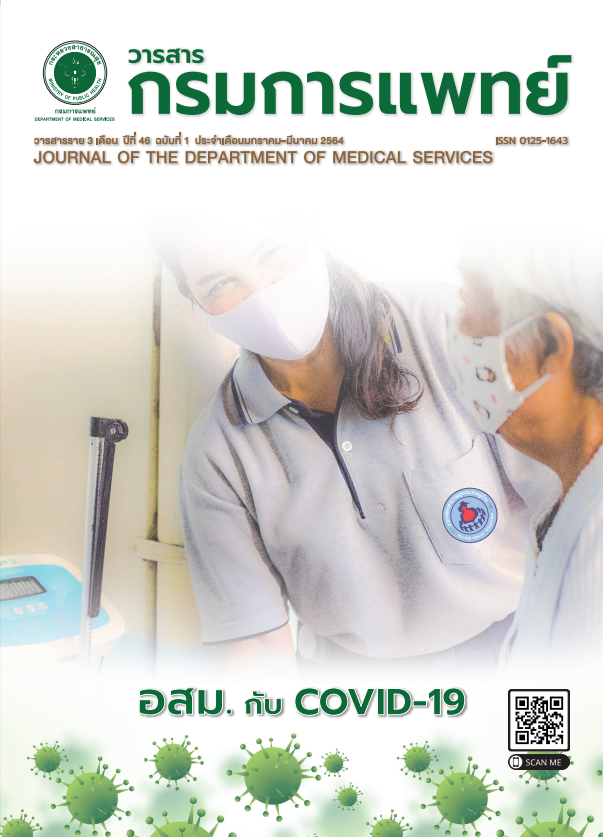9 watt-LED (T8) Phototherapy for Neonatal Jaundice in Lerdsin Hospital
Keywords:
Neonatal jaundice, LED (T8) phototherapy, Fluorescent (T8) phototherapyAbstract
Background : 18 watt fluorescent (T8) phototherapy is the standard treatment for neonatal jaundice. However, fluorescent is replaced by LED because of fluorescent use more energy than LED. We found that 9 watt LED (T8) phototherapy has enough light intensity for the treatment of neonatal jaundice.Objective : To study the effectiveness of 9 watt LED (T8) (8 light bulbs), developed in Lerdsin Hospital compare with 18 watt fluorescent (T8) (8 light bulbs) phototherapy in treating neonatal jaundice.Methods : This was randomized controlled trial study in 120 babies born during June to October 2019 with neonatal jaundice. The sample were divided into two groups by computer randomization and undergo the standardized physical examination and bilirubin’s level checkup. The light intensity was also measured at the beginning of treatment. Then, there was bilirubin testing every 24 hours until the end of treatment. Other routine nursing records were also done.Results : 9 watt LED (T8) phototherapy had statistical significantly higher light intensity than 18 watt fluorescence phototherapy. The rate of bilirubin level was decreased more in LED (T8) phototherapy compared to 18 watt fluorescent (T8) phototherapy at 24 and 48 hours of treatment. And, there was no change of patient’s temperature during treatment.Conclusions : The study of treating 60 patients diagnosis of neonatal jaundice with LED (T8) phototherapy found that the bilirubin level was more decreased than the treatment with the standard 18 watt-fluorescent (T8) phototherapy using in present.
References
Brown AK, Kim MH, Wu PY, Bryla DA. Efficacy of phototherapy in prevention and management of neonatal hyperbilirubinemia.Pediatrics 1985; 75:393-400.
Cockington RA. A guide to the use of phototherapy in the management of neonatal hyperbilirubinemia. J Pediatr 1979;95:281-5.
Brown AK, McDonagh AF. Phototherapy for neonatal hyperbilirubinemia: efficacy, mechanism and toxicity. Adv Pediatr 1980;27:341-89.
Maisels MJ. Neonatal jaundice. In: Avery GB, ed. Neonatology:pathophysiology and management of the newborn. 3rd ed.Philadelphia: Lippincott; 1987. p. 534-608.
McDonagh AF. Phototherapy: a new twist to bilirubin. J Pediatr 1981; 99:909-11.
Raethel HA. Wavelengths of light producing photodecomposition of bilirubin in serum from a neonate with hyperbilirubinemia. J Pediatr 1975; 87:110-14.
Dennery PA, Seidman DS, Stevenson DK. Neonatal hyperbilirubinemia. N Engl J Med 2001;344:581-90.
American Academy of Pediatrics Subcommittee on Hyperbilirubinemia. Management of hyperbilirubinemia in the newborn infant 35 or more weeks of gestation. Pediatrics 2004;114:297- 316.
Practice parameter: management of hyperbilirubinemia in the healthy term newborn. American Academy of Pediatrics. Provisional Committee for Quality Improvement and Subcommittee on Hyperbilirubinemia. Pediatrics 1994;94: 558-65.
Tan KL. Efficacy of fluorescent daylight, blue, and green lamps in the management of nonhemolytic hyperbilirubinemia. J Pediatr 1989;114:132-7.
De Carvalho M, De Carvalho D, Trzmielina S, Lopes JM, Hansen TW. Intensified phototherapy using daylight fluorescent lamps.Acta Paediatr 1999;88:768-71.
Chareonsiriwat V, Watanaprakornkul P. Light intensity of 8T8 (9 watts) LED bulbs phototherapy in the treatment of neonatal non-hemolytic jaundice. Thai Journal of Pediatrics 2019;58:11-7.
Chareonsiriwat V, Nakornchai K. Treatment of 60 neonatal jaundice term infants in Lerdsin Hospital:comparing the use of 8 bulds 9 watts (T8) LED Phototherapy and 8 bulds 18 watts (T8) fluorescent light phototherapy. Thai Journal of Pediatrics 2019;58:80-7.
Bernard R. Fundamentals of biostatistice. 5th ed. Duxbery:Thomson learning; 2000. p.308.
Ngamjarus C., Chongsuvivatwong V. (2014). n4Studies: Sample size and power calculations for iOS. The Royal Golden Jubilee Ph.D. Program - The Thailand Research Fund&Prince of Songkla University.
Maisels MJ, Kring EA, Deridder J. Randomized controlled trial of light-emitting diode phototherapy. J preinatal 2007;27: 565-7.
Jiang Hu, Xiaoyuan Li. Development of a portable high-power light-emitting diode phototherapy system for neonatal jaundice.Sheng Wu Yi Xue Gong Cheng Xue Za Zhi 2012; 29:89-92.
Chareonsiriwat V, Kajchamaporn W.The study of cost effectiveness between LED (T8) (9 watt) phototherapy and fluorescent (T8)(18 watt) phototherapy in the treatment of neonatal jaundice. Thai Journal of Pediatrics 2019;58:278-4.
Downloads
Published
How to Cite
Issue
Section
License

This work is licensed under a Creative Commons Attribution-NonCommercial-NoDerivatives 4.0 International License.
บทความที่ได้รับการตีพิมพ์เป็นลิขสิทธิ์ของกรมการแพทย์ กระทรวงสาธารณสุข
ข้อความและข้อคิดเห็นต่างๆ เป็นของผู้เขียนบทความ ไม่ใช่ความเห็นของกองบรรณาธิการหรือของวารสารกรมการแพทย์



